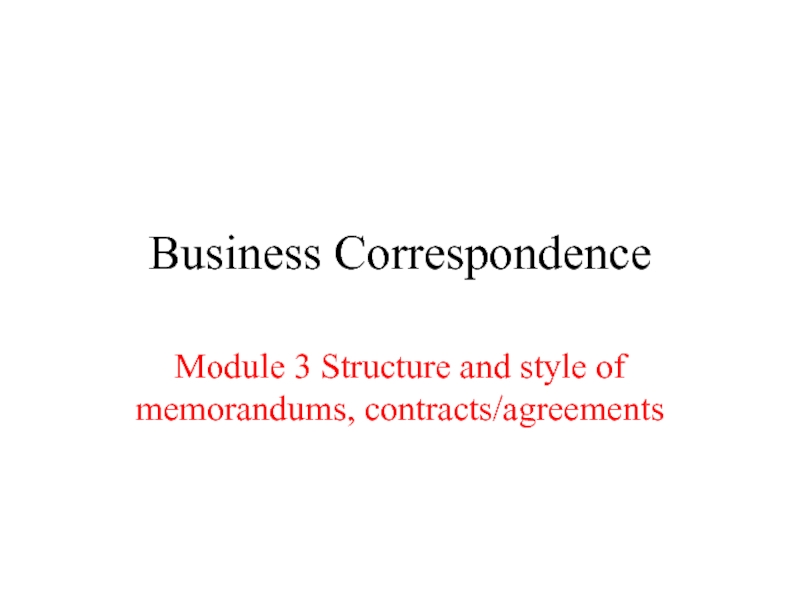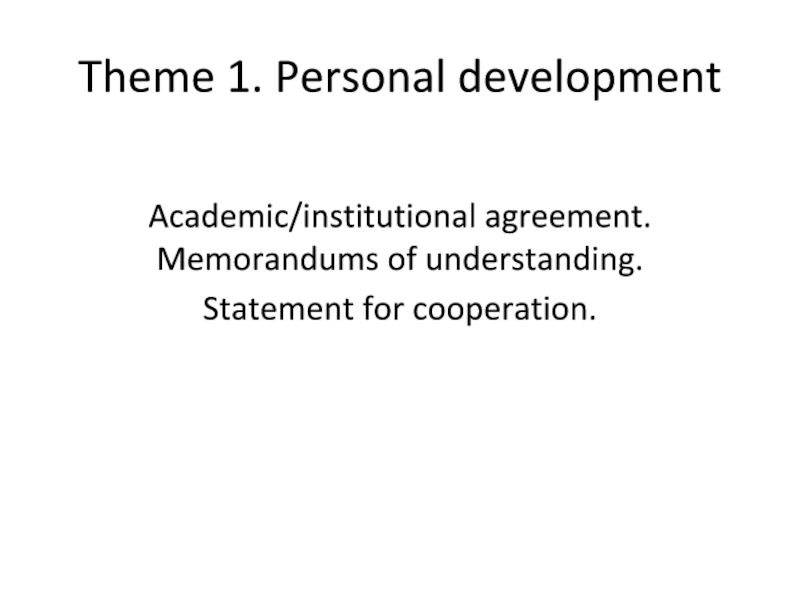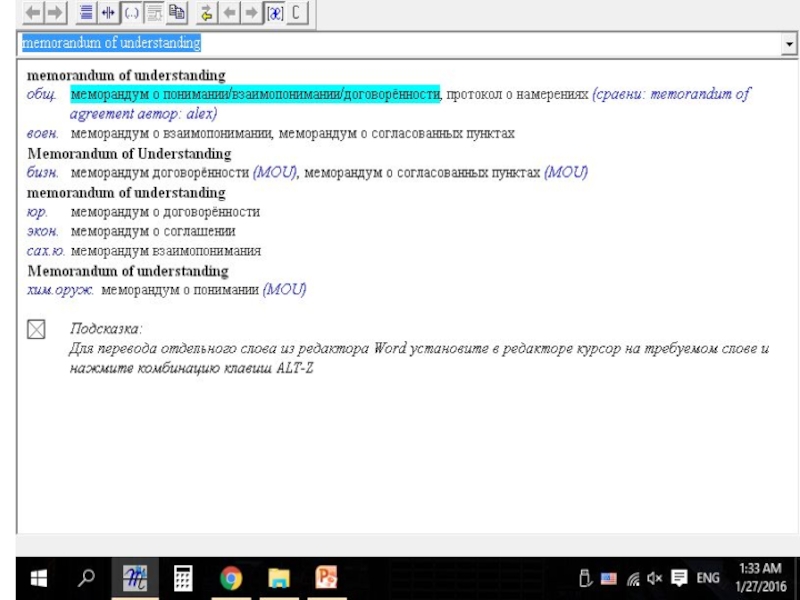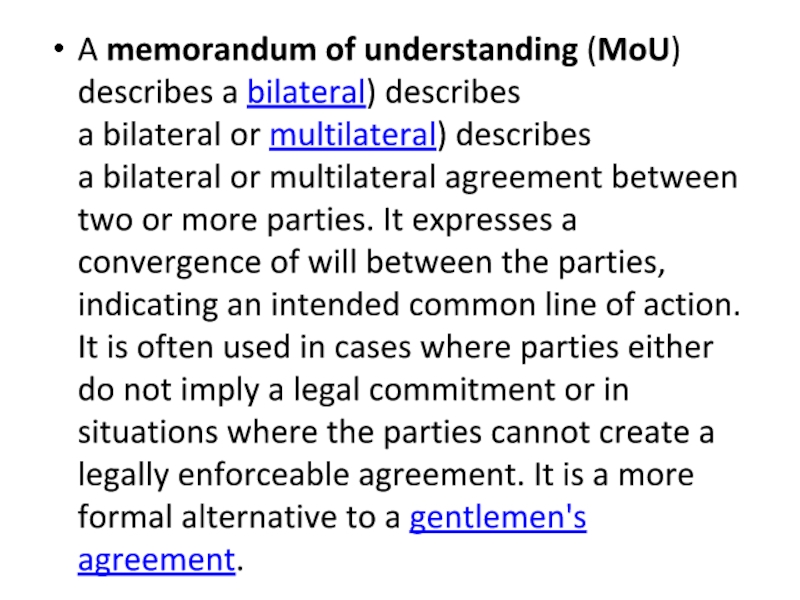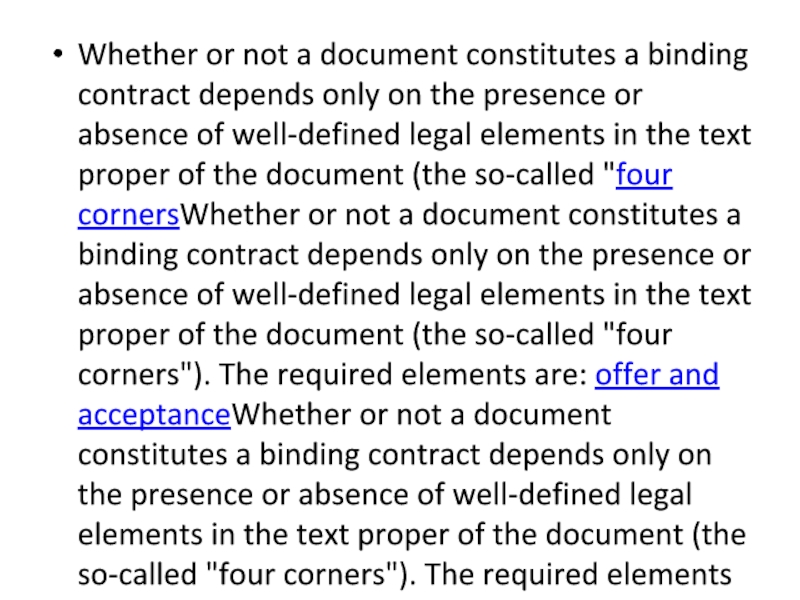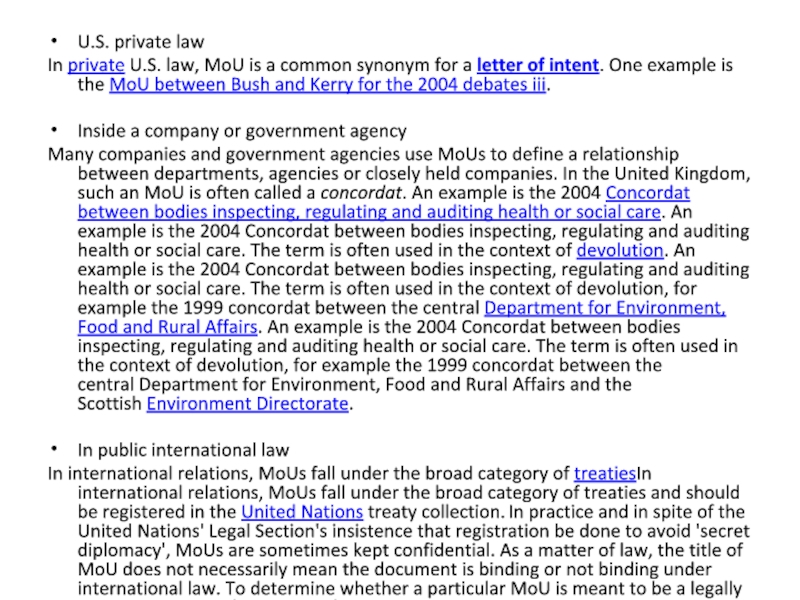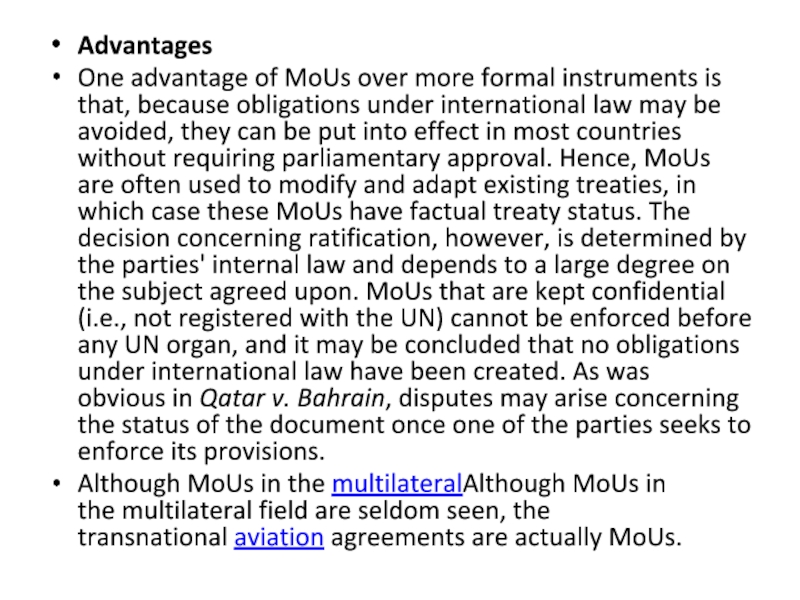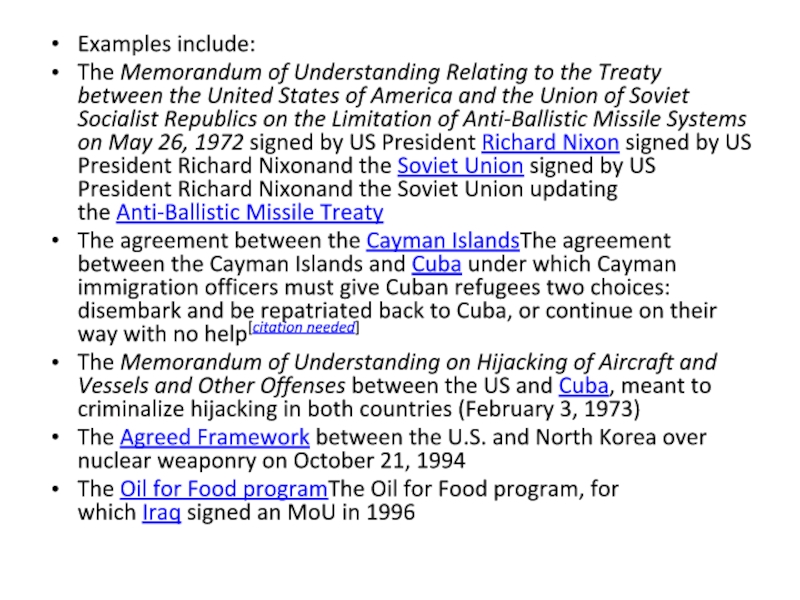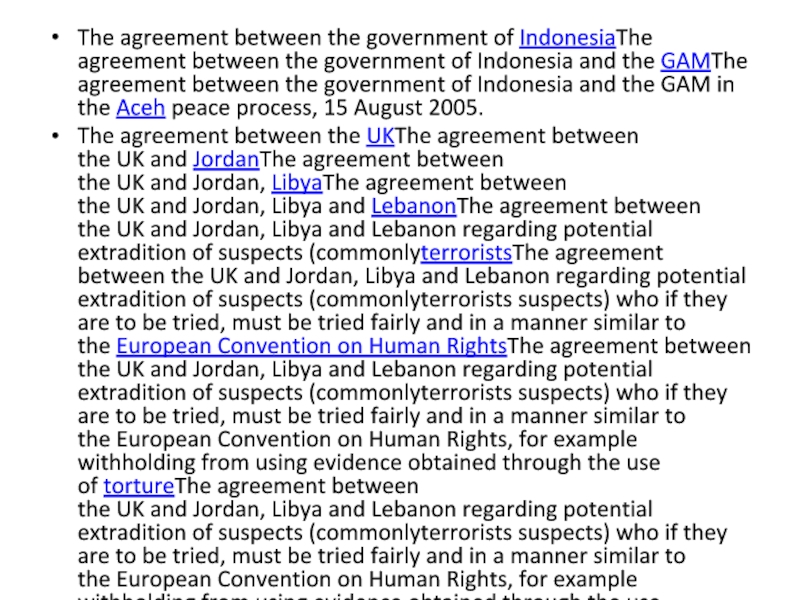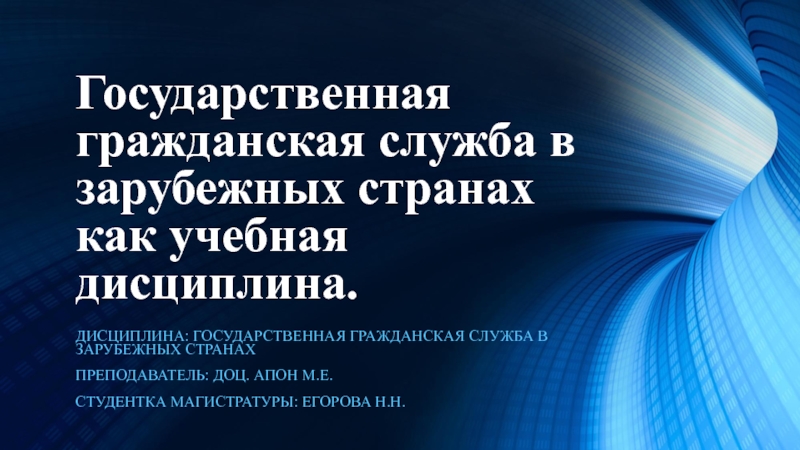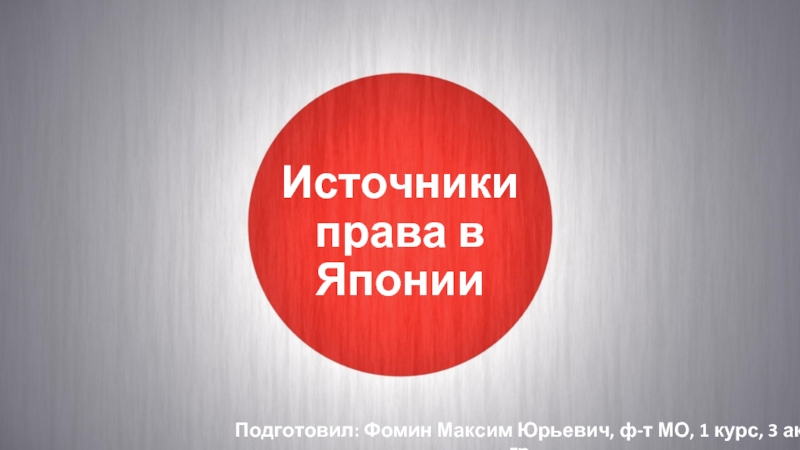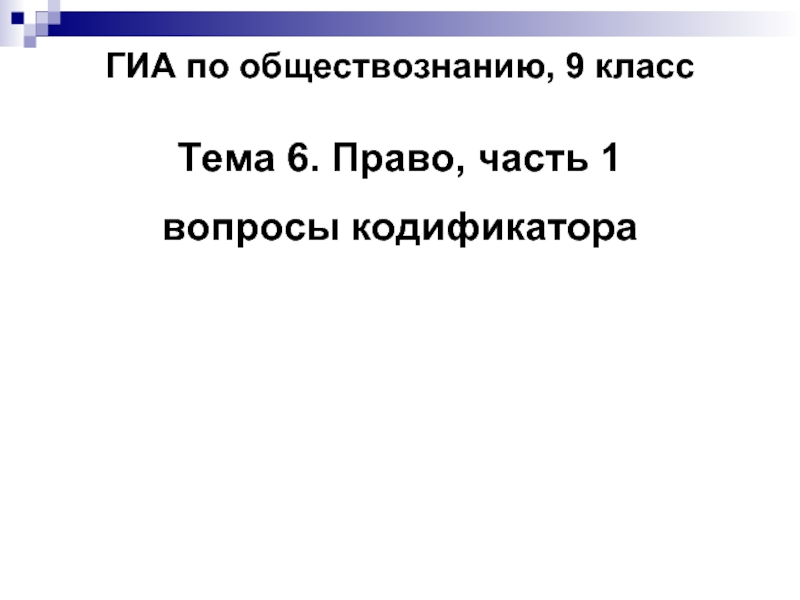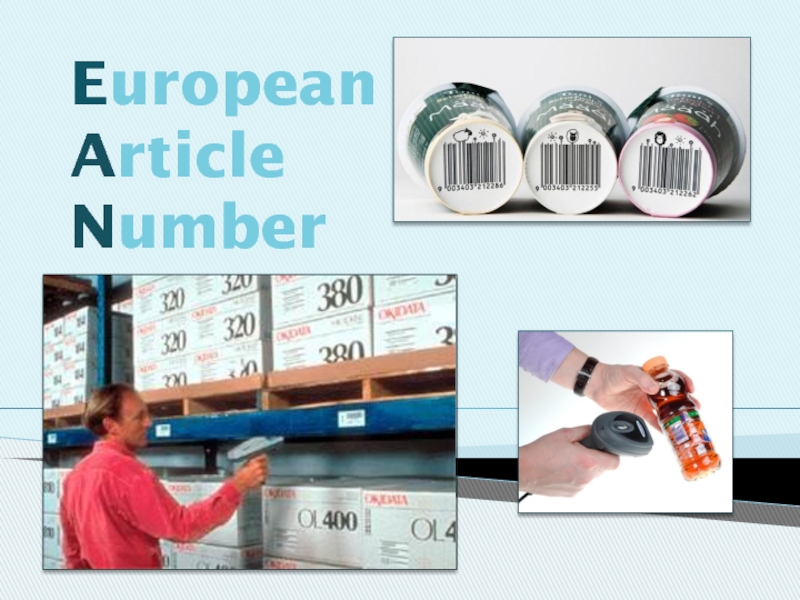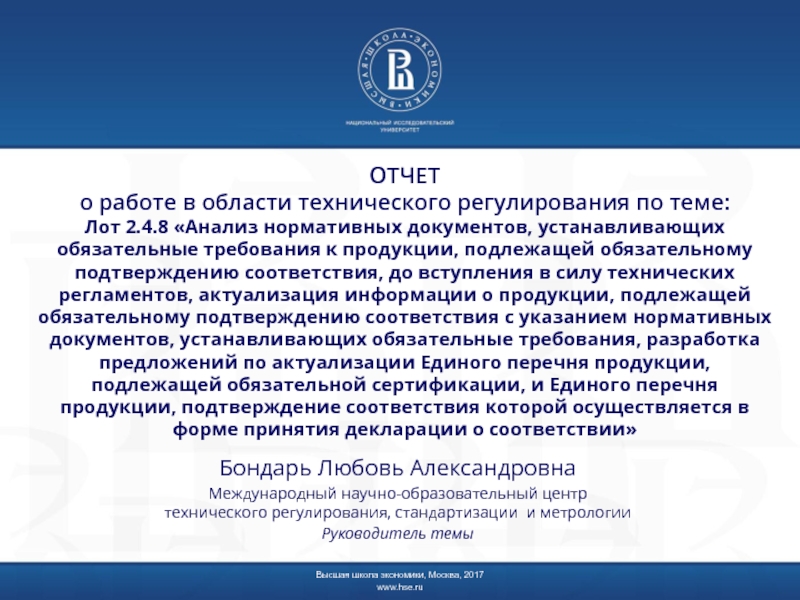- Главная
- Разное
- Дизайн
- Бизнес и предпринимательство
- Аналитика
- Образование
- Развлечения
- Красота и здоровье
- Финансы
- Государство
- Путешествия
- Спорт
- Недвижимость
- Армия
- Графика
- Культурология
- Еда и кулинария
- Лингвистика
- Английский язык
- Астрономия
- Алгебра
- Биология
- География
- Детские презентации
- Информатика
- История
- Литература
- Маркетинг
- Математика
- Медицина
- Менеджмент
- Музыка
- МХК
- Немецкий язык
- ОБЖ
- Обществознание
- Окружающий мир
- Педагогика
- Русский язык
- Технология
- Физика
- Философия
- Химия
- Шаблоны, картинки для презентаций
- Экология
- Экономика
- Юриспруденция
Structure and style of memorandums, contracts/agreements презентация
Содержание
- 1. Structure and style of memorandums, contracts/agreements
- 2. Theme 1. Personal development Academic/institutional agreement. Memorandums of understanding. Statement for cooperation.
- 4. A memorandum of understanding (MoU) describes a bilateral) describes a bilateral or multilateral)
- 5. Whether or not a document constitutes a
- 6. U.S. private law In private U.S. law, MoU is
- 7. Advantages One advantage of MoUs over more
- 8. Examples include: The Memorandum of Understanding Relating to
- 9. The agreement between the government of IndonesiaThe agreement
Слайд 2Theme 1. Personal development
Academic/institutional agreement. Memorandums of understanding.
Statement for cooperation.
Слайд 4A memorandum of understanding (MoU) describes a bilateral) describes a bilateral or multilateral) describes a bilateral or multilateral agreement between two
or more parties. It expresses a convergence of will between the parties, indicating an intended common line of action. It is often used in cases where parties either do not imply a legal commitment or in situations where the parties cannot create a legally enforceable agreement. It is a more formal alternative to a gentlemen's agreement.
Слайд 5Whether or not a document constitutes a binding contract depends only
on the presence or absence of well-defined legal elements in the text proper of the document (the so-called "four cornersWhether or not a document constitutes a binding contract depends only on the presence or absence of well-defined legal elements in the text proper of the document (the so-called "four corners"). The required elements are: offer and acceptanceWhether or not a document constitutes a binding contract depends only on the presence or absence of well-defined legal elements in the text proper of the document (the so-called "four corners"). The required elements are: offer and acceptance, considerationWhether or not a document constitutes a binding contract depends only on the presence or absence of well-defined legal elements in the text proper of the document (the so-called "four corners"). The required elements are: offer and acceptance, consideration, and theintention to be legally bound (animus contrahendi). In the U.S., the specifics can differ slightly depending on whether the contract is for goods (falls under the Uniform Commercial Code [UCC]) or services (falls under the common law of the state).
Слайд 6U.S. private law
In private U.S. law, MoU is a common synonym for a letter
of intent. One example is the MoU between Bush and Kerry for the 2004 debates iii.
Inside a company or government agency
Many companies and government agencies use MoUs to define a relationship between departments, agencies or closely held companies. In the United Kingdom, such an MoU is often called a concordat. An example is the 2004 Concordat between bodies inspecting, regulating and auditing health or social care. An example is the 2004 Concordat between bodies inspecting, regulating and auditing health or social care. The term is often used in the context of devolution. An example is the 2004 Concordat between bodies inspecting, regulating and auditing health or social care. The term is often used in the context of devolution, for example the 1999 concordat between the central Department for Environment, Food and Rural Affairs. An example is the 2004 Concordat between bodies inspecting, regulating and auditing health or social care. The term is often used in the context of devolution, for example the 1999 concordat between the central Department for Environment, Food and Rural Affairs and the Scottish Environment Directorate.
In public international law
In international relations, MoUs fall under the broad category of treatiesIn international relations, MoUs fall under the broad category of treaties and should be registered in the United Nations treaty collection. In practice and in spite of the United Nations' Legal Section's insistence that registration be done to avoid 'secret diplomacy', MoUs are sometimes kept confidential. As a matter of law, the title of MoU does not necessarily mean the document is binding or not binding under international law. To determine whether a particular MoU is meant to be a legally binding document (i.e., a treaty), one needs to examine the parties’ intent as well as the signatories' position (e.g., Minister of Foreign Affairs vs. Minister of Environment). A careful analysis of the wording will also clarify the exact nature of the document. The International Court of Justice has provided some insight into the determination of the legal status of a document in the landmark case of Qatar v. Bahrain, 1 July 1994.
Inside a company or government agency
Many companies and government agencies use MoUs to define a relationship between departments, agencies or closely held companies. In the United Kingdom, such an MoU is often called a concordat. An example is the 2004 Concordat between bodies inspecting, regulating and auditing health or social care. An example is the 2004 Concordat between bodies inspecting, regulating and auditing health or social care. The term is often used in the context of devolution. An example is the 2004 Concordat between bodies inspecting, regulating and auditing health or social care. The term is often used in the context of devolution, for example the 1999 concordat between the central Department for Environment, Food and Rural Affairs. An example is the 2004 Concordat between bodies inspecting, regulating and auditing health or social care. The term is often used in the context of devolution, for example the 1999 concordat between the central Department for Environment, Food and Rural Affairs and the Scottish Environment Directorate.
In public international law
In international relations, MoUs fall under the broad category of treatiesIn international relations, MoUs fall under the broad category of treaties and should be registered in the United Nations treaty collection. In practice and in spite of the United Nations' Legal Section's insistence that registration be done to avoid 'secret diplomacy', MoUs are sometimes kept confidential. As a matter of law, the title of MoU does not necessarily mean the document is binding or not binding under international law. To determine whether a particular MoU is meant to be a legally binding document (i.e., a treaty), one needs to examine the parties’ intent as well as the signatories' position (e.g., Minister of Foreign Affairs vs. Minister of Environment). A careful analysis of the wording will also clarify the exact nature of the document. The International Court of Justice has provided some insight into the determination of the legal status of a document in the landmark case of Qatar v. Bahrain, 1 July 1994.
Слайд 7Advantages
One advantage of MoUs over more formal instruments is that, because
obligations under international law may be avoided, they can be put into effect in most countries without requiring parliamentary approval. Hence, MoUs are often used to modify and adapt existing treaties, in which case these MoUs have factual treaty status. The decision concerning ratification, however, is determined by the parties' internal law and depends to a large degree on the subject agreed upon. MoUs that are kept confidential (i.e., not registered with the UN) cannot be enforced before any UN organ, and it may be concluded that no obligations under international law have been created. As was obvious in Qatar v. Bahrain, disputes may arise concerning the status of the document once one of the parties seeks to enforce its provisions.
Although MoUs in the multilateralAlthough MoUs in the multilateral field are seldom seen, the transnational aviation agreements are actually MoUs.
Although MoUs in the multilateralAlthough MoUs in the multilateral field are seldom seen, the transnational aviation agreements are actually MoUs.
Слайд 8Examples include:
The Memorandum of Understanding Relating to the Treaty between the United
States of America and the Union of Soviet Socialist Republics on the Limitation of Anti-Ballistic Missile Systems on May 26, 1972 signed by US President Richard Nixon signed by US President Richard Nixonand the Soviet Union signed by US President Richard Nixonand the Soviet Union updating the Anti-Ballistic Missile Treaty
The agreement between the Cayman IslandsThe agreement between the Cayman Islands and Cuba under which Cayman immigration officers must give Cuban refugees two choices: disembark and be repatriated back to Cuba, or continue on their way with no help[citation needed]
The Memorandum of Understanding on Hijacking of Aircraft and Vessels and Other Offenses between the US and Cuba, meant to criminalize hijacking in both countries (February 3, 1973)
The Agreed Framework between the U.S. and North Korea over nuclear weaponry on October 21, 1994
The Oil for Food programThe Oil for Food program, for which Iraq signed an MoU in 1996
The agreement between the Cayman IslandsThe agreement between the Cayman Islands and Cuba under which Cayman immigration officers must give Cuban refugees two choices: disembark and be repatriated back to Cuba, or continue on their way with no help[citation needed]
The Memorandum of Understanding on Hijacking of Aircraft and Vessels and Other Offenses between the US and Cuba, meant to criminalize hijacking in both countries (February 3, 1973)
The Agreed Framework between the U.S. and North Korea over nuclear weaponry on October 21, 1994
The Oil for Food programThe Oil for Food program, for which Iraq signed an MoU in 1996
Слайд 9The agreement between the government of IndonesiaThe agreement between the government of Indonesia and
the GAMThe agreement between the government of Indonesia and the GAM in the Aceh peace process, 15 August 2005.
The agreement between the UKThe agreement between the UK and JordanThe agreement between the UK and Jordan, LibyaThe agreement between the UK and Jordan, Libya and LebanonThe agreement between the UK and Jordan, Libya and Lebanon regarding potential extradition of suspects (commonlyterroristsThe agreement between the UK and Jordan, Libya and Lebanon regarding potential extradition of suspects (commonlyterrorists suspects) who if they are to be tried, must be tried fairly and in a manner similar to the European Convention on Human RightsThe agreement between the UK and Jordan, Libya and Lebanon regarding potential extradition of suspects (commonlyterrorists suspects) who if they are to be tried, must be tried fairly and in a manner similar to the European Convention on Human Rights, for example withholding from using evidence obtained through the use of tortureThe agreement between the UK and Jordan, Libya and Lebanon regarding potential extradition of suspects (commonlyterrorists suspects) who if they are to be tried, must be tried fairly and in a manner similar to the European Convention on Human Rights, for example withholding from using evidence obtained through the use of torture(Article 3). Such an understanding has been criticised for its inability to be legally enforced. This has been highlighted in the current deportation process of the suspected terrorist Abu Qatada, who is wanted by Jordan in connection with a terrorist attack. However, at present, the Court of Appeal have rejected the UK Government's appeal based on their concern at Jordan obtaining evidence potentially incriminating Qatada through the use of torture.
The Memorandums of Understanding on Labour Cooperation between The People's Republic of China between The People's Republic of China, Singapore between The People's Republic of China, Singapore and New Zealand on 2008, in parallel with their respective free trade agreements
The agreement between the UKThe agreement between the UK and JordanThe agreement between the UK and Jordan, LibyaThe agreement between the UK and Jordan, Libya and LebanonThe agreement between the UK and Jordan, Libya and Lebanon regarding potential extradition of suspects (commonlyterroristsThe agreement between the UK and Jordan, Libya and Lebanon regarding potential extradition of suspects (commonlyterrorists suspects) who if they are to be tried, must be tried fairly and in a manner similar to the European Convention on Human RightsThe agreement between the UK and Jordan, Libya and Lebanon regarding potential extradition of suspects (commonlyterrorists suspects) who if they are to be tried, must be tried fairly and in a manner similar to the European Convention on Human Rights, for example withholding from using evidence obtained through the use of tortureThe agreement between the UK and Jordan, Libya and Lebanon regarding potential extradition of suspects (commonlyterrorists suspects) who if they are to be tried, must be tried fairly and in a manner similar to the European Convention on Human Rights, for example withholding from using evidence obtained through the use of torture(Article 3). Such an understanding has been criticised for its inability to be legally enforced. This has been highlighted in the current deportation process of the suspected terrorist Abu Qatada, who is wanted by Jordan in connection with a terrorist attack. However, at present, the Court of Appeal have rejected the UK Government's appeal based on their concern at Jordan obtaining evidence potentially incriminating Qatada through the use of torture.
The Memorandums of Understanding on Labour Cooperation between The People's Republic of China between The People's Republic of China, Singapore between The People's Republic of China, Singapore and New Zealand on 2008, in parallel with their respective free trade agreements
